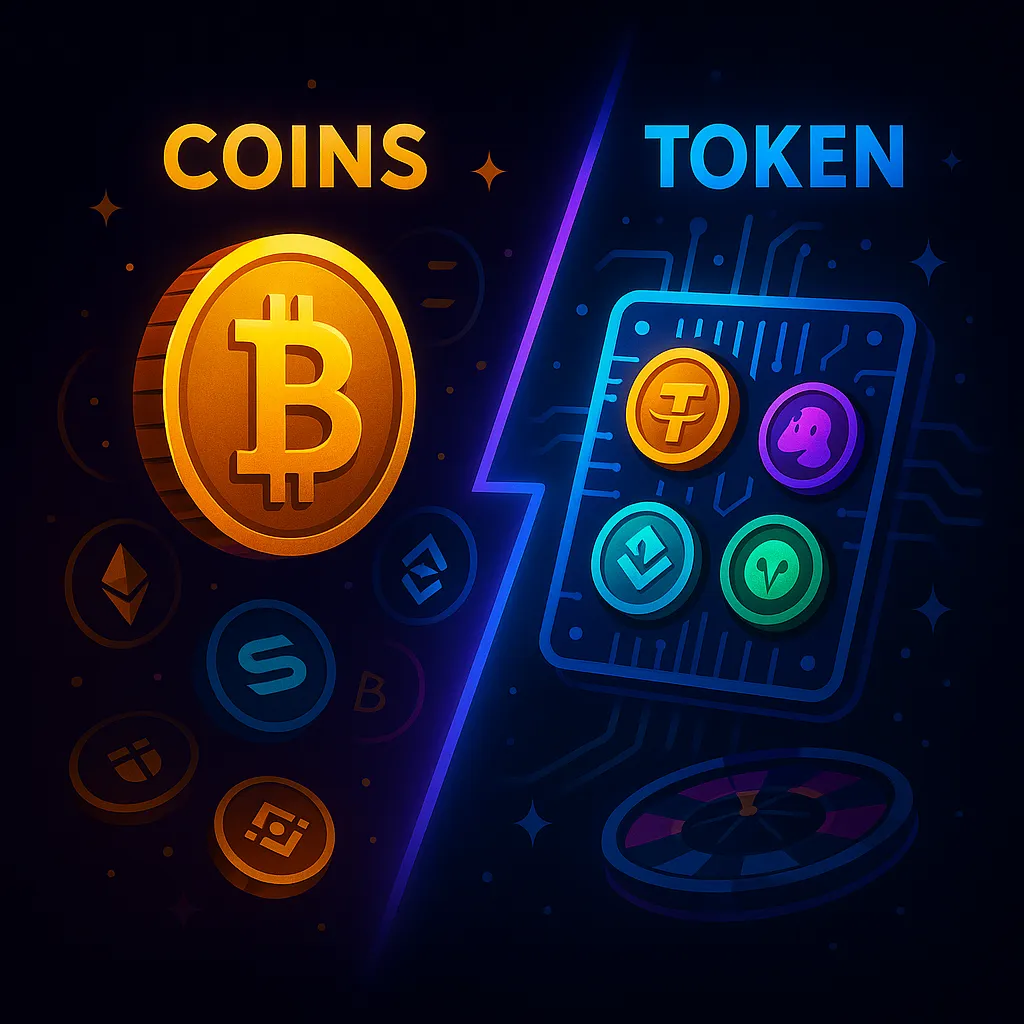If you’ve been hanging out in crypto chats, you’ve probably heard people throwing around “coins” and “tokens” like they’re the same thing. But here’s the truth: while all coins and tokens live in the crypto fam, they’re not the same species.
It’s like saying dollars and casino chips are the same — both can buy you something, but one is the real money and the other is just used inside a specific place.
Confused? No problem. Let’s break it down simple:
Quick Definitions
- Coin: Runs on its own blockchain. Think of it as the native money of that chain. Examples:
- Bitcoin (BTC) on the Bitcoin blockchain
- Ether (ETH) on Ethereum
- Solana (SOL) on Solana
- Token: Built on top of an existing blockchain. Doesn’t have its own chain, it just borrows someone else’s. Examples:
- USDT (Tether) = token on Ethereum, Tron, Solana, etc.
- Shiba Inu (SHIB) = ERC-20 token on Ethereum
- ApeCoin (APE) = ERC-20 token used for BAYC/NFT ecosystem
So: coins = blockchains’ native assets. Tokens = built on blockchains.
There are now over 10,000+ different cryptocurrencies listed on CoinMarketCap — but only about 300 coins have their own blockchains. The rest? Tokens.
A Simple Analogy
Imagine Ethereum is a big casino 🏦🎲.
- ETH = the casino’s own currency.
- Tokens like SHIB, APE, or USDT = chips that players create to run side games inside the casino.
Same environment, but ETH is the house money.
Coins vs. Tokens: Side-by-Side
| Feature | Coin | Token |
|---|---|---|
| Blockchain | Has its own (BTC, ETH, SOL) | Runs on someone else’s (ERC-20 on ETH, SPL on Solana) |
| Purpose | Payments, network fees, staking | Utility, governance, memes, stablecoins, in-app use |
| Examples | BTC, ETH, SOL, ADA, AVAX | USDT, SHIB, APE, UNI, PEPE |
| Creation | Built into blockchain code | Created with smart contracts |
| Security | Backed by the network’s miners/validators | Security depends on the host chain |
USDT (Tether) is the biggest token, moving over $50 billion in daily transactions — more than Visa processes on some days
Real-World Examples
- Coins:
- Pay gas fees on Ethereum with ETH.
- Use SOL to trade NFTs on Magic Eden.
- Bitcoin stands alone as digital gold.
- Tokens:
- USDT/USDC are stablecoins — the backbone of global crypto payments.
- Uniswap (UNI) is a governance token for the DEX.
- SHIB and PEPE are memes that became multi-billion-dollar ecosystems.
Bitcoin alone dominates with about 50% of the total $2 trillion crypto market cap (as of 2025).
Why It Matters
- Utility: Coins power their blockchains, tokens power apps and ecosystems.
- Investment style: Coins = usually more stable, tokens = more risky/more moonshot.
- Gas fees: You always pay gas with the coin, not the token. Example: moving SHIB on Ethereum costs ETH.
- Regulation: Bitcoin is treated differently by governments vs small meme tokens.
Risks
- Coins can still be volatile (BTC dropped from $69k → $16k in 2022).
- Tokens are even riskier: thousands have rugged, disappeared, or just died from no hype.
- Many tokens are pure speculation with no real use — be careful fam.
Meme tokens? SHIB once pumped an insane 43,000,000% in a single year (2021).
Quick Takeaways
- Coins = blockchain native money.
- Tokens = apps, memes, utilities built on top.
- Both matter in Web3 — coins keep the chains alive, tokens bring culture and experimentation.
- Learn the difference, and you won’t confuse buying ETH with aping into SHIB again.
Final Word
The coin vs token difference is simple but powerful. Coins are like nations’ currencies — dollars, pesos, euros. Tokens are like vouchers, chips, or reward points that only work inside specific systems.
Both can make (or lose) you money, both are essential for the Web3 casino. The key is knowing which one you’re playing with.
Because at the end of the day, Bitcoin and ETH might be the house money… but tokens like SHIB or PEPE remind us that sometimes, memes pay the rent.
Wagmi fam 🚀


